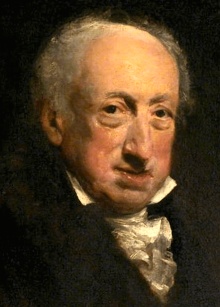
George Dance [also known as George Dance, the younger; and as George Dance, Junior] was born in London, England on 20 March 1741. He was the son of the architect George Dance, the elder (c.1694-1768) who had designed the Mansion House (1739-52) for the Lord Mayor of London. After training with his father in the fundamentals of architecture, in 1758 he went to Rome where he attended the Accademia di S. Luca, and over the next six years made a study of Roman antiquity. During this period, he was evidently influenced by the emerging style of neo-classicism.
Following his return from Rome in 1765, he joined his father's office. One of his first projects was the redesign the Church of All Hallows, London Wall. His father died in 1768 and he succeeded him as clerk of the City works and master of the Merchant Taylors’ Company in the City of London. Over the next three decades he designed a number of important public buildings in London including Newgate Prison and Sessions House (1770-84), alterations to Billingsgate Fish Market (1776) St Luke’s Hospital for Lunatics (1780) on Old Street, and the Shakespeare Gallery in Pall Mall (1788). He also worked on projects outside London including Pitzhanger Manor in Ealing, his own house (1768); Coleorton Hall in Leicestershire (1802); Laxton Hall in Northamptonshire (1794); Theatre Royal in Bath, (1804); and alterations to Ashburnham Place in Sussex (1812)
Dance designed several town planning schemes for London, however, few of them were realised, although his plans for Finsbury Circus and St George’s Circus were to influence the shape of London's cityscape.
With his brother, Nathaniel Dance, he was a founder member of the Royal Academy in on 10 December 1768 and in 1798 succeeded Thomas Sandby as Professor of Architecture at the Academy, however, he didn't give a single lecture and resigned his post in 1806. He died in Bloomsbury, London on 14 January 1825.
For a detailed list of architectural projects by George Dance see Colvin, 4th edition, 2008 pp. 297-299
Black, Iain. ‘George Dance the Younger and the rebuilding of Martins Bank, 1791-95’. Georgian Group Journal vol. 31, 2023, pp. 125-144.
Blomfield, Reginald. ‘The architect of Newgate’ [George Dance, the Younger]. Architectural Review vol. 10, 1901 pp. 123-138
Colvin, Howard, A Biographical Dictionary of British Architects 1600-1840. New Haven, Connecticut and London: Yale University Press, 4th edition, 2008
Daniels, J. ‘George Dance, father and son, and an exhibition at the Geffrye Museum’ Connoisseur July 1972 pp. 182-190
George Dance, the elder 1695-1768, the younger 1741-1825. [Catalogue of an exhibition held at the Geffrye Museum, London] London: Inner London Education Authority, 1972
Hugo-Brunt, Michael ‘George Dance, the younger, as town planner (1768-1814).’ Society of Architectural Historians. Journal December 1955 pp. 13-22
Kerney, Michael. ‘Ammonites in architecture: the 'ammonite order' was invented by the neo-Classical architect, George Dance’. Country Life vol. 173, no. 4458, 27 January 1983 pp. 214-218.
Lever, Jill Rosemary. 'Architecture unshackled' : George Dance the Younger 1741-1825. London: Soane Gallery, 2003.
Lever, Jill Rosemary. Catalogue of the drawings of George Dance the Younger (1741-1825) and of George Dance the Elder (1695-1768) from the collection of Sir John Soane's Museum. Oxford : Oxford University Press, 2003
Rosenau, H. ‘George Dance the younger.’ RIBA Journal August 1947 pp.502-507
Service, Alastair. The Architects of London and their buildings from 1066 to the present. London: The Architectural Press, 1979
Stroud, Dorothy. George Dance architect 1741-1825. London : Faber, 1971.
Stroud, Dorothy. ‘The Giltspur Street Compter; architect (1787) : George Dance the Younger’. Architectural History vol. 27, 1984, pp. 127-134.
Stroud, Dorothy. ‘The novelty of the Guildhall facade, London’[Influence of Indian architecture. Architect George Dance, the Younger]. Country Life 2 April 1964 pp.770-771
‘Newgate Prison’ [Architect: George Dance the Younger] The Builder vol. 69, 21 December 1895 pp. 455-456, 462 + 1 plate